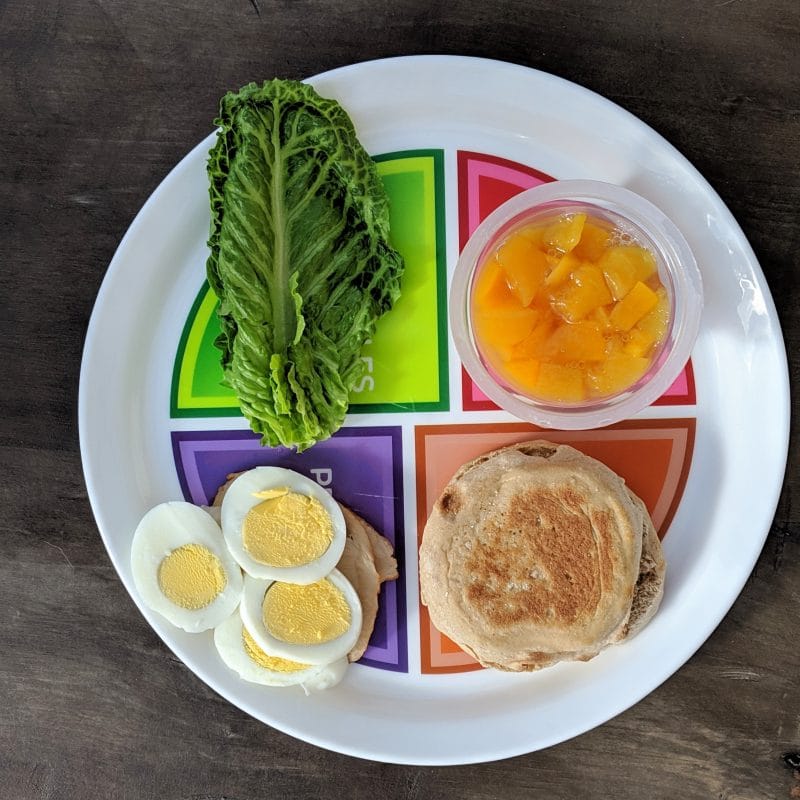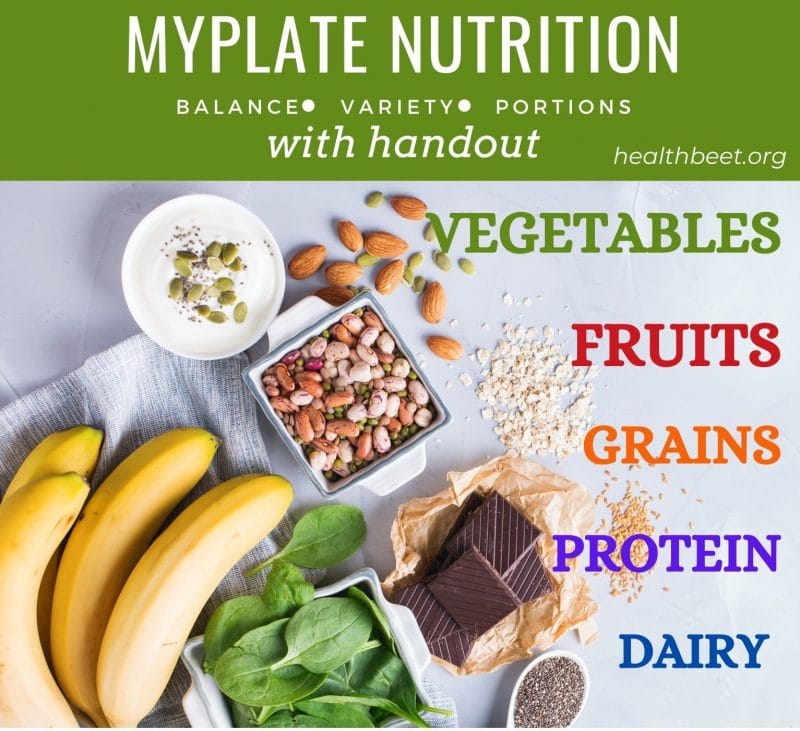Nutrition Basics with PDF
Nutrition isn’t complicated. However, the information overload we see online often makes nutrition feel overwhelming, confusing, and contradictory. But true nutrition basics aren’t controversial. Eat a variety of whole foods, focusing on fruits and veggies, and avoid overeating.
My community presentations usually touch on these nutrition basics. Sending a handout or PDF home helps to reinforce the information. When you focus on scientific nutrition basics, and avoid controversial nuances, people feel empowered to make change that is long term. You’ll have a better chance at good health by eating your fruits and veggies, than if you spent time worrying about the timing of your meals, or whether you use a microwave or not.
When I give a community lecture and teach about nutrition basics, I break down the discussion into the following four bullet points.
- Why it’s important to eat healthy food.
- What is a balanced diet.
- How each food group contributes to overall health.
- How portion control, variety, and mindfulness contribute to health.
Nutrition Basics: Why it’s important to eat healthy food
Good nutrition not only impacts your future health, but also how you feel right now. Today. A poor diet can make you feel lethargic, ill, and weak. Healthy food can help you be energized immediately. Studies have confirmed, good nutrition:
- Can help build immunity to help fight short term infections.
- Can protect from chronic diseases in the future.
- Can help you maintain a healthy weight to feel better overall.
- Can improve your mood and enhance mental outlook.
- Can improve memory.
- Can strengthen bones and muscles.
What is nutrition?
Nutrition is the science of food and health. It studies how we obtain nutrients from food and the effect is has on in our bodies.
What is a balanced diet?
Balanced eating can be summed up in one word: variety! Not only eating from a variety of food groups, but also a variety of food within those food groups. Each food group provides important and vital macro and micro-nutrients that are essential for growth, development and body function.
How each food group contributes to overall health:

Want to save this post?
Enter your email below and get it sent straight to your inbox.
Proteins
Foods containing protein are an essential part of balanced eating. On a portion plate, the protein comprises 1/4 of the meal.
Amino acids found in proteins provide structure for muscle tissue, bone and skin. Protein is essential for life sustaining chemical reactions in the body, internal communication of cells, immune support, and is a source of energy and regulation.
Our main dietary source of protein is from meat, eggs, legumes, nuts, and seeds.

Vegetables
Veggies are important in a balanced diet, as they provide essential micronutrients necessary for development and function. Studies repeatedly show people who eat a diet high in vegetables have fewer rates of chronic diseases.
Vegetables are plant food such as carrots, broccoli, cauliflower, peppers, squash, string beans, kale, and lettuce. It’s important to eat a variety of vegetables as each sub-group of veggies, by color provide different nutrients. You can also increase the variety of veggies by cooking them in a variety of ways. Roasted, sauteed, steamed, baked, or raw can all taste so different and help you to find a way you enjoy a certain vegetable.
Fruits
Fruits help make a balanced diet as a healthy, whole food source of carbohydrates, fiber, and micronutrients. Fruit is rich in potassium, vitamin C, and folate.
The fiber in fruit is vital for healthy digestive functioning. Fruit includes such foods as bananas, apples, strawberries, blueberries, grapefruit, oranges, watermelon and more.
In eating a variety of fruit, you can enjoy fruit all year long by eating them them fresh, frozen, canned, dried, juiced, and blended.
Grains
Many are surprised to see grains on the balanced plate, as many new diets promote removing grains from your diet. However, grains are still considered essential to optimal health. Grains are a great source of energy in the form of carbohydrates, as well as B Vitamins. Whole grains can provide a good source of fiber and can be of benefit by providing a good environment for healthy bacteria to grow.
The USDA recommends half your grains should be whole grains. This can be obtained through oats, corn, barley, quinoa, rye, and whole wheat.
Dairy
Dairy made the list of a food group to have a balanced diet because it still is considered an easy, convenient food group to get essential calcium to build bones. Additionally, dairy also includes phosphorus, potassium, magnesium, and vitamins A, B12, and riboflavin. Some items in the dairy category include milk, cheese, and yogurt. Many non-dairy plant based milks on the market today are fortified with calcium and vitamin D, making them also a good source of “dairy” for those who may be lactose intolerant.
What about fats?
A question I get a lot about is why we haven’t included fats as it’s own food group category on Choose MyPlate. My explanation has always been that fats can be found in every food group. There are plenty of fats in the protein group, such as fish, nuts, and seeds. Avocados and olives are a great source of fat and can be found in the vegetable and fruit group. Even quinoa has a small amount of fat and is include in the grain category. Using fats in your diet from whole food sources like these food groups, is nutritionally superior that obtaining your fats through processed sources like oils.
How portion control contributes to good health.
Even a healthy diet can be damaging and lead to inflammation if you are eating too much food. Overeating and excessive calories of food can be difficult to digest and cause discomfort, weight gain, fatigue, and create an environment that is taxing on your internal organs. Practicing portion control is essential to good health and nutrition, even when you are eating healthy food.
Portion control can be practiced in a few ways. You can divide your plate into 4 food groups, and limit your servings at that meal to having one serving of food in each section. (Read, How to Use Choose MyPlate here)

You can also practice mindful eating, and check in with yourself mid-meal to assess your fullness. If you are practicing mindful eating, it’s critical to avoid distractions during mealtime so you can focus on feeling your hungry and satiety meter. Stop eating when you aren’t quite full and still feel comfortable.
Not only can mindfulness help you eat eat less food overall, but paying attention to your food has been shown to have positive health outcomes, such as better digestion!
Sticking to the basics of nutriton!
Not only is this outline the basics of nutrition, but it’s also the things that will have the BIGGEST impact on your health. Organic foods, meal timing, glycemic index, macro counting etc. is all fun to research, but will not make as big of a difference in how you feel as will eating a variety of foods, from all the food groups, and eating those foods in the right amounts.
Share this handout with friends, family and students with this printable below!
Nutrition Basics Free Printable
RESOURCES:




Thank you for all of your great information! I appreciate that you shared meal prep. pages and portion control.